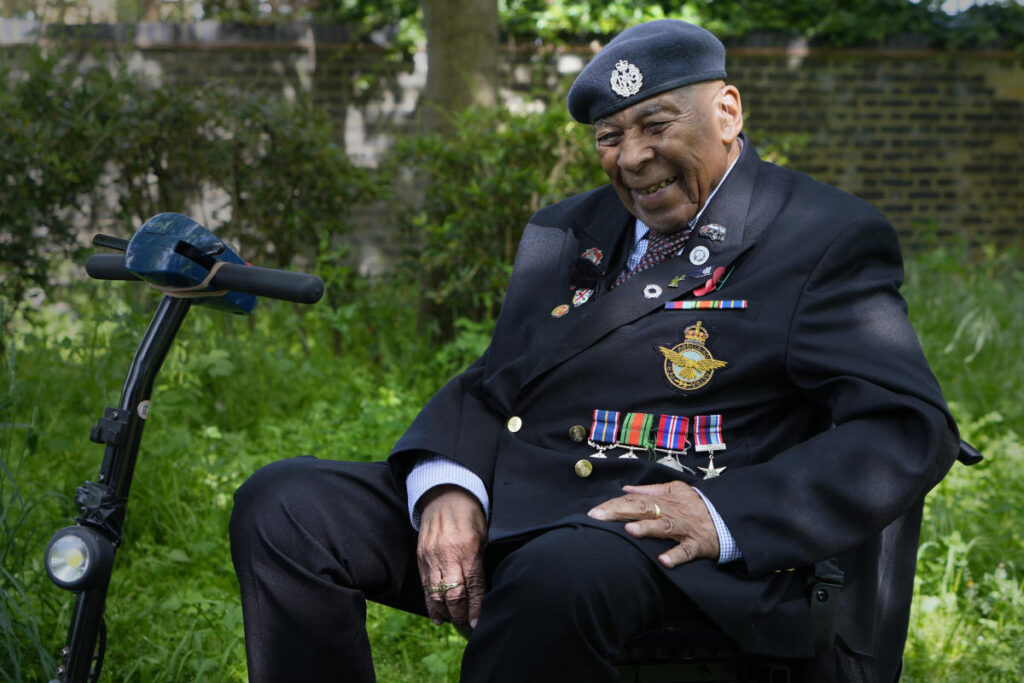LONDON (AP) — Gilbert Clarke leans back on the seat of his mobility scooter, stretches his neck and stares at the clear blue sky above east London as he remembers the moment 80 years ago when he knew the invasion of France was underway used to be.
Clarke, then an 18-year-old Royal Airforce volunteer from Jamaica, was still a trainee learning the intricacies of radar systems when the roar of aircraft engines forced him to look skyward on June 6, 1944.
“You couldn’t have seen the blue sky,” Clarke recalled eighty years later in an awestruck voice. ‘They were all planes. Hundreds and thousands of them – all shapes and sizes. All different types of planes. The instructor (said) ‘Hmm. Well guys, it’s started. ”
“We all shouted, ‘Give them hell,’ or probably something much stronger than that.”
Clarke was allowed to make his own contribution after completing his training a few weeks later and was posted to a series of air bases where he operated the radio and radar systems of British and American aircraft for the rest of the war. He plans to travel there Northern France later this week k, together with other veterans of the Battle of Normandy for ceremonies marking the 80th anniversary of the D-Day landings which began the campaign to liberate Europe from Nazi rule.
Clarke, now 98, is one of more than three million men and women from South Asia, Africa and the Caribbean who served in the British Army during the Second World War. Citizens of what was still the British Empire volunteered to fight for ‘king and country’, as did recruits from the British Isles, but their service is often overlooked.
Britain’s former colonies were crucial to the Allied victory because they provided money and resources, as well as manpower, to support the war effort after the Nazis occupied Europe and threatened to invade Britain, said George Hay, a historian of the Commonwealth War Graves Commission. . These contributions should be remembered along with the sacrifices of those who fought and died on the beaches of Normandy, he said.
“It’s incredibly important what those men managed to do that one day on the beaches,” Hay said. “But what gets them there and what keeps them there and what allows them to continue fighting from there is much bigger than those actually putting their feet on the sand.”
This includes ground crew members like Clarke, who had the unglamorous but crucial job of maintaining the aircraft that were crucial to the success of the Normandy campaign.
The RAF was a popular destination for black volunteers because the air force lifted the ‘colour bar’ shortly after the outbreak of war and began recruiting in the Caribbean in 1940. By the end of the war, approximately 6,000 West Indian men had enlisted in the RAF. RAF, with 450 assigned to aircrew and another 5,500 serving on the ground. Eighty women joined the Women’s Auxiliary Air Force.
Many of the recruits faced racism, despite an official ban on discrimination. Yet many flourished.
One of the most decorated West Indian volunteers was navigator Philip Louis Ulric Cross, born in Trinidad and Tobago, who served in 80 missions over Germany and Europe. Cross, who died in 2013, was awarded the Distinguished Flying Cross and promoted to squadron leader before leaving the RAF. He later served as a Supreme Court judge in Trinidad and returned to London in 1990 as High Commissioner for Trinidad and Tobago.
Clarke was a teenager in Montego Bay when he heard reports of German submarines attacking ships in the Caribbean and thought war was coming to Jamaica. Instead of waiting for that to happen, he decided to sign up.
“We were all in a situation where someone had to do something to put an end to what was going on,” Clarke said softly, a Jamaican tinge still in his voice. “And (I’m) proud that I did my little part.”
Still, there was a ‘flow of tears’ when Clarke went home to say goodbye. He soon found himself aboard a troopship that was part of a convoy attacked by U-boats, but he reached Liverpool safely and was assigned to a base in northern England for training.
Life in the RAF turned out to be a series of Nissen huts, prefabricated structures made from corrugated iron, arched over a semi-circular frame and heated with a single wood or coal stove.
“The black volunteers had learned a lot about Britain at school and most felt they were in reality ‘coming home’ to the mother country,” according to an exhibition at the RAF Museum. “When they arrived here, however, many experienced culture shock” due to the cold weather, lack of Caribbean food and the fact that most white Britons had never met a black person.
Yet Clarke decided to remain in England after the war, where he used his RAF training to earn a living ‘by fixing everything with a wire’.
Like other veterans, on ceremonial occasions he proudly wears his RAF beret and a dark cloak, decorated with medals and military insignia. But in Clarke’s case, the decorations aren’t just to celebrate his service. It also reminds the world that men who look like him came to Britain’s aid in its hour of need.
While he avoids questions about racism he has faced over the years, Clarke acknowledges that black people in Britain still face discrimination.
He hopes his story, and those of other black veterans, will help change that.
“We are someone,” he said. “We did something for the presence of all the people here. I feel very proud.”







